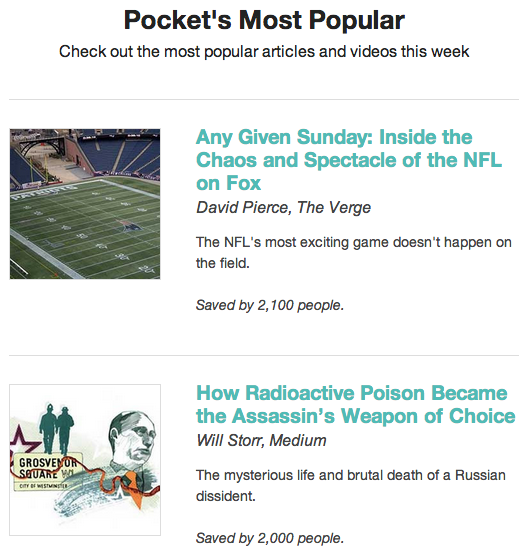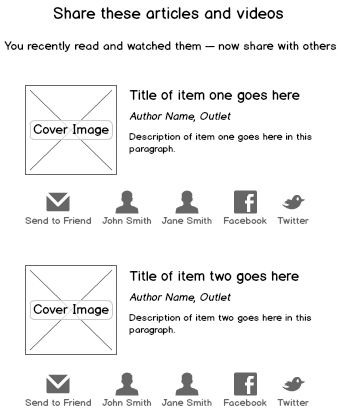This is the first of a series of posts where I’ll be looking at potential improvements to products.
Pocket is one of my favorite apps and I was recently asked what I’d improve about it. The Pocket team has done a lot of great work outside of the app, including:
- An ease of adding content into your items list for future consumption: you can save items to Pocket via email, a bookmarklet, and hundreds of apps
- The ability to use the app on many devices, including smartphones, tablets, computers, and even some e-readers (they’ve integrated with Kobo)
I point this attention to outside the app because the consumption experience and sharing capabilities inside the app are pretty good. There are always opportunities for tweaks and optimizations, but some higher impact changes can potentially be made in the areas of discovery and sharing when users are outside the app. I think the Pocket team knows this, as they recently began sending a weekly email to users with a few suggestions of popular items that you may be interested in.

This email is aimed at increasing engagement via discovery of new content, potentially resulting in more items being added to Pocket. So now Pocket has made advancements with discovery outside the app, but what’s still missing for me is a nudge to share content more than I currently do.
I rarely share content via Pocket with others. I use the app for a few minutes at a time (such as when I’m on the subway), so my focus is on reading what I have time for and then moving onto something off my device (such as getting off the train). Sharing doesn’t need to only take place inside the app — I’d explore a way to get users to share items when they’re not using the app.
The goal here is to increase virality through users sharing items. More items shared = more potential new users of Pocket. I’d experiment here with a periodic email sent to users that nudges them to share items that they’ve already consumed. This is different from the ‘discovery’ focused email described above, as here the user is already familiar with the content (it’d be a few items they’ve consumed within the past week) and can make a quick decision to share it.

- If the user is on mobile and the Pocket app is installed on the device, tapping on a sharing icon would open the app and put the user into the app’s existing sharing mechanism to complete the share based on the selection they made in the email (e.g., tapping to share via Facebook)
- If the user is on mobile and the Pocket app is not installed on the device, tapping on a sharing icon would open the web app in the device’s browser with the user auto-logged in and they could complete the share
- If the user is on desktop, clicking on a sharing icon would open the web app with the user auto-logged in and they could complete the share
The best number of items to include in the email could be A/B tested, but for the sake of this post let’s go with 4. Here’s how they’d be selected:
- If the user consumed 5 or more items during the past week that they didn’t already share, include the 4 that were most popular based on what other Pocket users have also consumed
- If the user consumed between 1 and 4 items during the past week that they didn’t already share, include all of those items
- If the user consumed 0 items during the past week, send the same ‘discovery’ email that Pocket currently sends (with no built-in sharing element)
In some cases a user will have only consumed articles and no videos, or vice versa, but here we’ll assume it’s both.
Depending on which metrics are most important to Pocket, the results of this new ‘sharing’ email (the goal being to increase user acquisition via some of the people who receive a shared item) could trump the results of the existing ‘discovery’ email (the goal being to increase engagement from the primary user).
One option is to combine the ‘discovery’ and ‘sharing’ emails to introduce a couple of new items to the user along with a couple of already-consumed items that they may want to share. This could be tested.

The following would be tracked from the emails to measure success:
- Email open rate
- Click-through rate on items within the email
- Shares that originated from the email
- New users that resulted from a share from the email
Success would primarily be determined by new users that resulted from the shares. A secondary benefit would be increased engagement by existing users who either share items or receive shared items.

